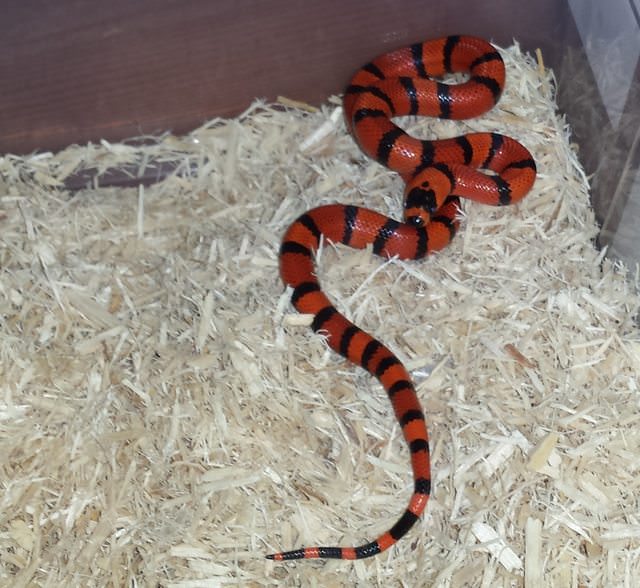

Coral snakes have adjacent red and yellow bands, while milk snakes’ are red and black. To tell the difference between the two, look to see which bands of colors are touching. This causes milk snakes to frequently be misidentified as the venomous coral snake. The most common tri-color combination of a milk snake is red, black, and white. The Difference Between Milk Snakes and Coral Snakes While useful in the wild, this successful copycat technique results in humans erroneously killing these harmless and gentle reptiles. This is a defense mechanism known as Batesian mimicry, where one species adopts characteristics of another to ward off predators. The similarity of a milk snakes pattern and coloration is no accident. Unfortunately, their vivid colors often cause them to be mistaken for coral snakes or copperheads. Are There Any Types of Milk Snakes That Are Venomous? This means that there is no difference in length or appearance between male and female snakes. Unlike most other snake species, milk snakes are not sexually dimorphic. The length of a milk snake will vary depending on its place of origin. While most milk snakes are small (around 2 feet long), certain subspecies can average 4 or 5 feet long. Conditions like albinism (as seen in the albino Nelson’s milk snake) create even more morphs to select from.Īside from their color and pattern, the biggest difference between types of milk snakes is their length. The typical coloration involves three colors, which is why this species is sometimes referred to as a “tricolor”. Milk snakes are colorful come in a variety of dazzling color combinations. Part of the reason why milk snakes are so prominent in the pet trade is that there are 8 subspecies native to the U.S. They can be found throughout the entire North American continent from South America to southern Canada. This nonvenomous species has the largest geographical range of any land snake. Size, coloration, and pattern of a milk snake will vary depending on the subspecies’ geographical place of origin. They are a species of kingsnakes, the colubrid New World constrictors, and part of the genus Lampropeltis. Types of Milk Snakesĭespite their namesake, milk snakes have nothing to do with milk, cows, or the like. This is not surprising given that they are part of the Kingsnake genus – which is widely recommended as one of the best snakes for beginners. Caring for a milk snake is relatively low maintenance as they do not have stringent temperature, humidity, or lighting requirements.

Milk snakes ( Lampropeltis triangulum) are popular amongst novice and experienced snake owners alike.Their docile disposition, manageable size, and adaptability make them well suited to be kept as pets. The wide variety of milk snake morphs is just one of the many reasons why these species are so popular.

Each milk snake subspecies offers pet owners a different set of color variations and patterns. Snake lovers looking for a visually striking pet won’t be disappointed. Known for their vibrant appearances and friendly behavior, milk snakes are a fun pet snake to have. In fact, there are 24 milk snake subspecies with half of them being commonly found at pet stores. Information courtesy of, wikipedia.Choosing a milk snake as a pet can be difficult since there are many types of milk snakes to choose from. Many predators confuse them with the venomous coral snake and will retreat. This is all in an attempt to startle the predator and warn them of danger. These snakes would rather flee than fight, but if cornered they will raise their head and make quick “jerky†movements to flash their colors. Many times, these snakes have appetites larger than stomachs, causing them to regurgitate their food because they are unable to digest the large prey. They hunt mice, rats, birds and other small mammals. They are a non-venomous snake but rather a constrictor. They are nocturnal in the summer and diurnal in the spring and fall and hibernate in the winter. In the wild, they have a life span of about 12 years, but in captivity they can live over 20 years. As adults, these snakes reach lengths of 3 to 5 feet and some are now exceeding 6 feet. They have a signature “M†pattern under the mouth. The original Honduran Milksnake was tri-colored, orange/red, black and yellow or orange bands down the body. The colors morphs are creating a high demand for these snakes by collectors and hobbyist. These snakes have a rapidly growing color morph, primarily bright orange, dull orange, reds, blacks, gray or even pure white. They make their home in the rain forests. The Honduran Milksnake is a milksnake and as its name implies, originates in Nicaragua, Honduras and even parts of Costa Rica. Honduran Milksnake (Lampropeltis triangulum Hondurensis)


 0 kommentar(er)
0 kommentar(er)
